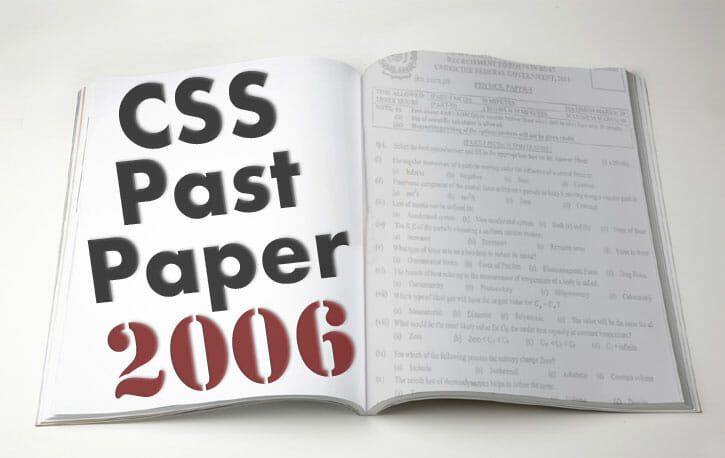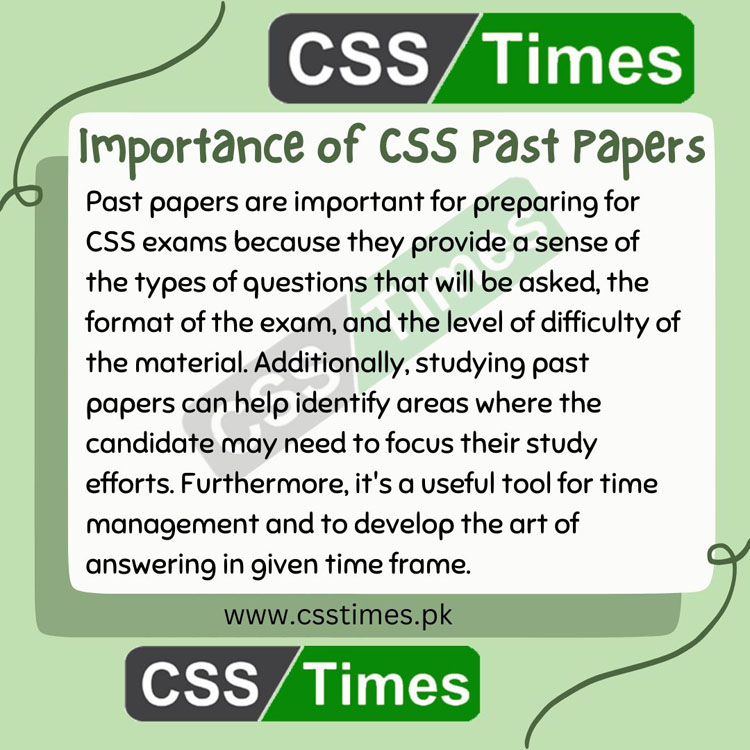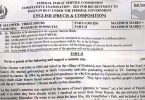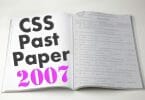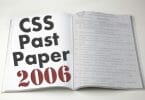CSS EVERYDAY SCIENCE Paper 2006
FEDERAL PUBLIC SERVICE COMMISSION
COMPETITIVE EXAMINATION FOR RECRUITMENT TO POSTS
IN B.P.S. -17, UNDER THE FEDERAL GOVERNMENT, 2006
GENERAL KNOWLEDGE PAPER- I
(EVERYDAY SCIENCE)
Time Allowed: 3 Hours Maximum Marks: 100
Note: (i) Attempt ONLY TEN questions. All questions carry EQUAL marks.
(ii) Extra attempt of any question or any part of the attempted question will not be considered.
(iii) Draw diagram where necessary and write clearly.
1. Write short notes on only TWO of the following: (5 each)
(a) Magnetic Resonance Imaging
(b) Tidal Energy
(c) Supersonics
Read also: CSS English Essay Paper 2021
2. What is Pollen Allergy? What preventive measures are to be taken to avoid it? (4,6)
3. Name: (1 each)
(1) The alloy consisting of metals copper, zinc and nickel.
(2) The instrument specially designed for recording earthquake waves.
(3) The electrical device which converts sound energy into electrical energy.
(4) The ore of mercury metal.
(5) The device with which variation of blood flow can be heard.
(6) The element, which is abundantly present in the human body.
(7) The scientist who discovered penicillin.
(8) The astronaut who first landed on the surface of moon.
(9) The desert mammal, which does not drink water.
(10) The mode of heat transfer from the sun to the earth.
4. Write briefly (not more than four to five sentences) about only FIVE of the following: (2 each)
(a) Plaster of Paris (b) Theodolite
(c) Bird Flu (d) Gene
(e) Thermistor (f) Thermostat
(g) Pedometer
Check also: Everyday Science MCQs
5. Which physical quantities are measured by the following units? (1 each)
(a) Foot-Pound (b) Torr
(c) Slug (d) Gauss
(e) Acre Foot (f) Becquerel
(g) Erg (h) Dyne
(i) Gilbert (j) Dioptre
6. What is the difference between Dam and Barrage? What benefits are obtained by constructing a big dam? (2,8)
7. Which of the following statements are True and which are False: (1 each)
(a) Pitch of the dog sound is greater than the pitch of the cat sound.
(b) Ultraviolet light is visible but infrared light is not visible.
(c) Earthquakes are the lamps illuminating the structure of the earth’s exterior.
(d) Electricity does not move through a wire but through a field around the wire.
(e) A guava contains more vitamin C than an orange.
(f) Sound travels faster in iron than in air.
(g) Wheat stone Bridge is the name of an electrical circuit.
(h) Morphine can cause constipation and lowering of blood pressure.
(i) A concave lens is used for the correction of the Hyperopia.
(j) The nucleic acids are responsible for proteins synthesis in the human body.
8. Differentiate between the following pairs: (2 each)
(a) Telemeter and Multimeter (b) Perimeter and Altimeter
(c) Periscope and Microscope (d) Nucleon and Photon
(e) Cusec and Comet
9. Fill in the blanks: (1 each)
(1) The branch of zoology, which deals with the study of insects is called _______.
(2) The disease _______ is caused by the deficiency of Vitamin B1 (Thiamine).
(3) Oil rises in a wick of oil lamp because of a property of matter, called _______.
(4) The production of genetically identical reproduction is called as _______.
(5) _______ is the farthest planet of the solar system.
(6) Mercury metal is _______ times heavier than water.
(7) Relative density of milk is measured by an instrument known as _______.
(8) The temperature of a human body is measured by an instrument known as _______ thermometer.
(9) Gold and silver are known as _______ metals.
(10) The amount of ozone in the atmosphere is expressed in _______.
10. What is global warming? Is there a sunny side to global warming? If yes, explain. (4,6)
11. Give scientific reasons of the following: (2 each)
(a) Why do some people snore?
(b) Why do we sometimes sleep walk?
(c) Climber bends forward while climbing a mountain.
(d) The manhole covers are generally round.
(e) Roads are bent inwards on curves.
12. What are vitamins and minerals? Which vitamins and minerals play major role in the development of bones? (4,6)
13. What do the following scientific abbreviations stand for? (1 each)
(1) CRO (2) SARS
(3) BOT (4) AMU
(5) EMF (6) ADH
(7) STP (8) GeV
(9) NTP (10) CRT
14. Compare the columns A and B and write the correct answer from the column B corresponding to the column A (serial wise) in column C. (1 each)
| Column A | Column B | Column C | |
| (1) | Geiger Muller Counter | Semi Conductor | (1) |
| (2) | Newton | Magnet | (2) |
| (3) | Addison | Electricity | (3) |
| (4) | Bardeen and Brattin | Radioactivity | (4) |
| (5) | Weber Fehner’s Law | E.M. Induction | (5) |
| (6) | Benjamin Franklin | Lightening Conductor | (6) |
| (7) | Decibel | Gravitation | (7) |
| (8) | Dr. Gilbert | Water | (8) |
| (9) | Henry Cavendish | Sound | (9) |
| (10) | Faraday | Non-conductor | (10) |
15. Choose the best choice in the following statements: (1 each)
(1) One of the countries through which Equator passes is:
(a) Kenya (b) Malaysia
(c) Malta (d) Pakistan
(2) Copper can be converted into gold by:
(a) Artificial radioactivity (b) Heating
(c) Electroplating (d) Chemical reaction
(3) The three elements needed for healthy growth of plants are:
(a) N, P, K (b) N, C , P
(c) N, K, C (d) N, S, P
(4) Clocks, which moves with velocities comparable with the velocity of light, run:
(a) fast
(b) Slow
(c) equal to the velocity of light
(d) with zero velocity
(5) Max Planck received the noble prize in physics in 1918 for his discovery of:
(a) electron (b) energy quanta
(c) photon (d) positron
(6) Bronze medal is made of metals:
(a) (copper, nickel) (b) (copper, tin)
(c) (copper, silver) (d) (copper, zinc)
(7) Addison’s disease is caused by the excessive secretion of:
(a) Antiduretic Harmone
(b) Luteinising Harmone
(c) Melanophore stimulating Harmone
(d) Adrenocorticotrophic Harmone
(8) Development of calf muscles in ladies who wear high heels is a common example of:
(a) Natural selection
(b) inheritance of acquired character
(c) Use and disuse of organ
(d) Artificial selection
(9) Margalla Hill is a branch of:
(a) Karakorum range (b) Hindukash range
(c) Himalaya range (d) Nanga Parbat range
(10) Humming bird belongs to a category called:
(a) Ectotherm (b) Endotherm
(c) Exotherm (d) Heterotherm
Check more CSS Past Papers below:
- CSS Pakistan Affairs Paper 2021 | FPSC CSS Past Papers 2021
- CSS Political Science Paper-I 2021 | FPSC CSS Past Papers 2021
- CSS International Relations Paper-II 2021 | FPSC CSS Past Papers 2021
- CSS International Relations Paper-I 2021 | FPSC CSS Past Papers 2021
- CSS Current Affairs Paper 2021 | FPSC CSS Past Papers 2021
- CSS General Science & Ability Paper 2021 | FPSC CSS Past Papers 2021
- CSS Islamic Studies Paper 2021 | FPSC CSS Past Papers 2021
- CSS English Essay Paper 2021 | FPSC CSS Past Papers 2021
- CSS English (Precis & Composition) Paper 2021 | FPSC CSS Past Papers 2021
- Computer Science, PAPER-II CSS 2020 | FPSC CSS Past Papers 2020
- Computer Science, PAPER-I CSS 2020 | FPSC CSS Past Papers 2020
- ACCOUNTANCY AND AUDITING, PAPER-II CSS 2020 | FPSC CSS Past Papers 2020
- ACCOUNTANCY AND AUDITING, PAPER-I CSS 2020 | FPSC CSS Past Papers 2020
- Political Science CSS Paper-II 2020 | FPSC CSS Past Papers 2020
- Political Science CSS Paper-I 2020 | FPSC CSS Past Papers 2020
- International Relations CSS Paper-II 2020 | FPSC CSS Past Papers 2020
- International Relations CSS Paper-1 2020 | FPSC CSS Past Papers 2020
- Islamic Studies CSS Paper 2020 | FPSC CSS Past Papers 2020
- Pakistan Affairs CSS Paper 2020 | FPSC CSS Past Papers 2020
- Current Affairs CSS Paper 2020 | FPSC CSS Past Papers 2020
- General Science & Ability Paper 2020 | FPSC CSS Past Papers 2020
- CSS English (Precis & Composition) Paper 2020 | FPSC CSS Past Papers 2020
- CSS English Essays Paper 2020 | FPSC CSS Past Papers 2020
- International Law CSS Paper 2019 | FPSC CSS Past Papers 2019
- Agriculture & Forestry CSS Paper 2019 | FPSC CSS Past Papers 2019
- Constitutional Law CSS Paper 2019 | FPSC CSS Past Papers 2019
- Environmental Science CSS Paper 2019 | FPSC CSS Past Papers 2019
- Gender Studies CSS Paper 2019 | FPSC CSS Past Papers 2019
- Sindhi CSS Paper 2019 | FPSC CSS Past Papers 2019
- Pushto CSS Paper 2019 | FPSC CSS Past Papers 2019
- Punjabi CSS Paper 2019 | FPSC CSS Past Papers 2019
- Balochi CSS Paper 2019 | FPSC CSS Past Papers 2019
- Journalism & Mass Communication CSS Paper 2019 | FPSC CSS Past Papers 2019
- Psychology CSS Paper 2019 | FPSC CSS Past Papers 2019
- Sociology CSS Paper 2019 | FPSC CSS Past Papers 2019
- Geography CSS Paper 2019 | FPSC CSS Past Papers 2019
- CSS Anthropology Paper 2019 | FPSC CSS Past Papers 2019
- CSS Computer Science, Paper-II 2019 | FPSC CSS Past Papers 2019
- CSS Economics Paper-II 2019 | FPSC CSS Past Papers 2019
- Economics , Paper-I CSS 2019 | FPSC CSS Past Papers 2019
- Accountancy and Auditing, Paper-2 CSS 2019 | FPSC CSS Past Papers 2019
- Computer Science, Paper-I CSS 2019 | FPSC CSS Past Papers 2019
- Accountancy and Auditing, Paper-I CSS 2019 | FPSC CSS Past Papers 2019
- Political Science – II CSS Paper 2019 | FPSC CSS Past Papers 2019
- International Relations – II CSS Paper 2019 | FPSC CSS Past Papers 2019
- International Relations – I CSS Paper 2019 | FPSC CSS Past Papers 2019
- Political Science Paper-I – CSS Paper 2019 | FPSC CSS Past Papers 2019
- Islamic Studies – CSS Paper 2019 | FPSC CSS Past Papers 2019
- Pakistan Affairs – CSS Paper 2019 | FPSC CSS Past Papers 2019
- Current Affairs – CSS Paper 2019 | FPSC CSS Past Papers 2019

